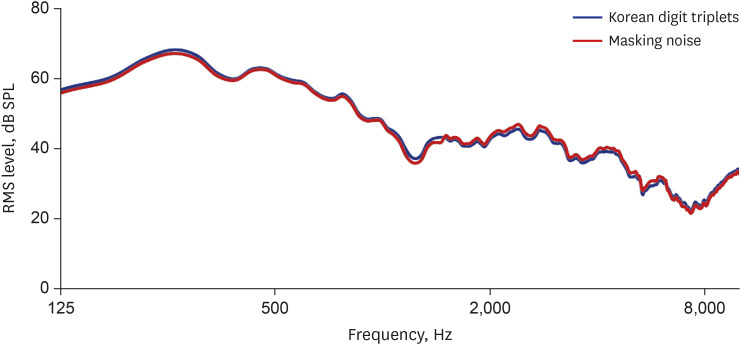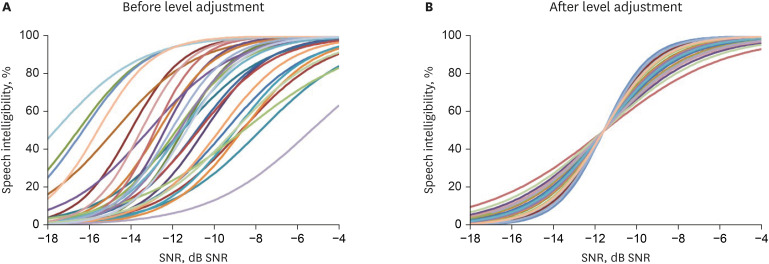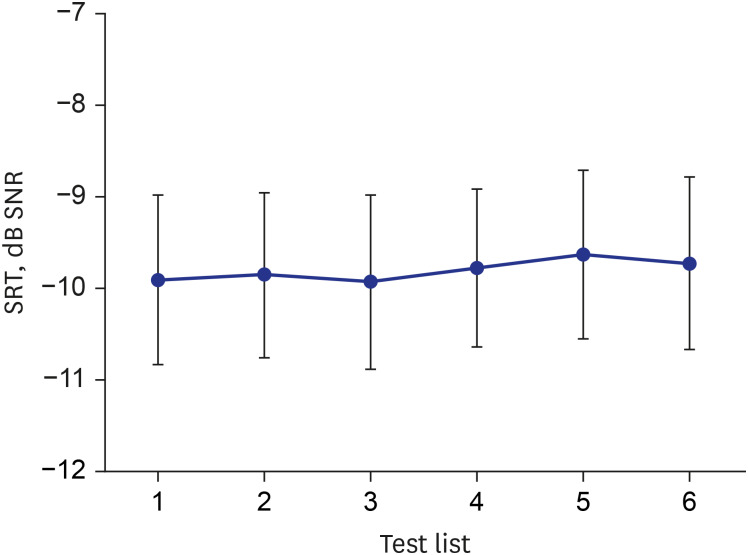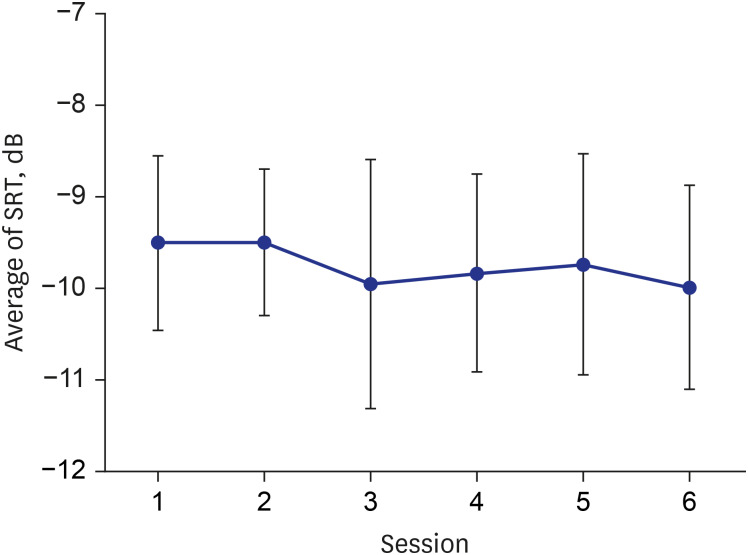J Korean Med Sci.
2020 Jun;35(21):e163. 10.3346/jkms.2020.35.e163.
Development of a Smartphone-Based Digits-in-Noise Test in Korean: a Hearing Screening Tool for Speech Perception in Noise
- Affiliations
-
- 1Laboratory of Brain & Cognitive Sciences for Convergence Medicine, Hallym University College of Medicine, Anyang, Korea
- 2Department of Computer Engineering, Pukyong National University, Busan, Korea
- 3Department of Otorhinolaryngology-Head and Neck Surgery, Hallym University Sacred Heart Hospital, Hallym University College of Medicine, Anyang, Korea
- KMID: 2502242
- DOI: http://doi.org/10.3346/jkms.2020.35.e163
Abstract
- Background
The digits-in-noise (DiN) test is a speech-in-noise test to measure speech recognition threshold in noise adaptively. Herein, we aimed to develop the Korean version of the DiN test to provide a useful hearing screening tool for clinical as well as research purposes. Method: Spoken monosyllabic digits from 0 to 9 were recorded by a female speaker. The test list was constructed such that each digit was placed in three different positions. An optimization procedure was conducted to equate the audibility of each digit. After the optimization, the smartphone application for the Korean DiN (K-DiN) test was developed. For the adaptive measurement procedure, 180 new DiN triplets separated into six lists of 30 were created. Mean speech recognition threshold values for each list and session were measured to examine the test-retest and training effects of the test materials. In addition, speech recognition threshold values measured by different devices were compared to determine whether the speech recognition threshold levels differed.
Results
Optimization results showed that the mean speech recognition threshold and slope were −11.55 dB signal-to-noise ratio and 10.21%/dB, respectively, which are comparable to levels shown in different-language versions of the DiN test. The results of the test-retest and training effects revealed no significant differences among the test sessions and lists. Additionally, the mean speech recognition threshold values measured by four different devices were not different, indicating the reliability of the test materials.
Conclusion
We believe this study is the first to attempt to develop a K-DiN test. Our results indicate that this test can be used as a potentially reliable hearing screening tool.
Keyword
Figure
Reference
-
1. Colgan S, Gold L, Wirth K, Ching T, Poulakis Z, Rickards F, et al. The cost-effectiveness of universal newborn screening for bilateral permanent congenital hearing impairment: systematic review. Acad Pediatr. 2012; 12(3):171–180. PMID: 22583631.
Article2. Curhan G, Curhan S. Epidemiology of hearing impairment. In : Popelka G, Moore B, Fay R, Popper A, editors. Hearing Aids. Springer Handbook of Auditory Research, Vol. 56. Cham: Springer;2016. p. 21–58.3. Smits C, Kapteyn TS, Houtgast T. Development and validation of an automatic speech-in-noise screening test by telephone. Int J Audiol. 2004; 43(1):15–28. PMID: 14974624.
Article4. Dimitrijevic A, Smith ML, Kadis DS, Moore DR. Cortical alpha oscillations predict speech intelligibility. Front Hum Neurosci. 2017; 11:88. PMID: 28286478.
Article5. Vlaming MS, MacKinnon RC, Jansen M, Moore DR. Automated screening for high-frequency hearing loss. Ear Hear. 2014; 35(6):667–679. PMID: 25127323.
Article6. Smits C, Theo Goverts S, Festen JM. The digits-in-noise test: assessing auditory speech recognition abilities in noise. J Acoust Soc Am. 2013; 133(3):1693–1706. PMID: 23464039.
Article7. Moore DR, Ferguson MA, Edmondson-Jones AM, Ratib S, Riley A. Nature of auditory processing disorder in children. Pediatrics. 2010; 126(2):e382–90. PMID: 20660546.
Article8. Lagacé J, Jutras B, Gagné JP. Auditory processing disorder and speech perception problems in noise: finding the underlying origin. Am J Audiol. 2010; 19(1):17–25. PMID: 20308289.
Article9. Döge J, Baumann U, Weissgerber T, Rader T. Single-sided deafness: impact of cochlear implantation on speech perception in complex noise and on auditory localization accuracy. Otol Neurotol. 2017; 38(10):e563–9. PMID: 29135878.
Article10. Belleville S, Rouleau N, Van der Linden M, Collette F. Effect of manipulation and irrelevant noise on working memory capacity of patients with Alzheimer's dementia. Neuropsychology. 2003; 17(1):69–81. PMID: 12597075.
Article11. Ziegler JC, Pech-Georgel C, George F, Lorenzi C. Speech-perception-in-noise deficits in dyslexia. Dev Sci. 2009; 12(5):732–745. PMID: 19702766.
Article12. Heine C, Slone M. The impact of mild central auditory processing disorder on school performance during adolescence. J Sch Health. 2008; 78(7):405–407. PMID: 18611216.
Article13. Lee SJ, Park KW, Kim LS, Kim H. Effects of noise level and cognitive function on speech perception in normal elderly and elderly with amnestic mild cognitive impairment. Cogn Behav Neurol. 2016; 29(2):68–77. PMID: 27336804.
Article14. Jansen S, Luts H, Wagener KC, Frachet B, Wouters J. The French digit triplet test: a hearing screening tool for speech intelligibility in noise. Int J Audiol. 2010; 49(5):378–387. PMID: 20380611.
Article15. Zokoll MA, Wagener KC, Brand T, Buschermöhle M, Kollmeier B. Internationally comparable screening tests for listening in noise in several European languages: the German digit triplet test as an optimization prototype. Int J Audiol. 2012; 51(9):697–707. PMID: 22762202.
Article16. Potgieter JM, Swanepoel DW, Myburgh HC, Hopper TC, Smits C. Development and validation of a smartphone-based digits-in-noise hearing test in South African English. Int J Audiol. 2016; 55(7):405–411.
Article
- Full Text Links
- Actions
-
Cited
- CITED
-
- Close
- Share
- Similar articles
-
- Relationship between Speech Perception in Noise and Phonemic Restoration of Speech in Noise in Individuals with Normal Hearing
- A Comparison Between the Korean Digits-in-Noise Test and the Korean Speech Perception-in-Noise Test in Normal-Hearing and Hearing-Impaired Listeners
- Efficacy of the Digit-in-Noise Test: A Systematic Review and Meta-Analysis
- Effects of Ageing and Hearing Thresholds on Speech Perception in Quiet and in Noise Perceived in Different Locations
- Bilateral Cochlear Implantation in Four Children





